Microsoft's new Surface Pro is a powerful machine with a slight drawback
When it launched back in 2012, Microsoft’s (MSFT) Surface was little more than a reference design for the company’s Windows 8 operating system. Unfortunately, Windows 8 was a disaster. But the Surface hardware proved to be a diamond in the rough thanks to its simple, 2-in-1 laptop-tablet design.
Which brings us to the new Surface Pro. The follow-up to Microsoft’s excellent Surface Pro 4, the new Surface Pro — there’s no number designation for this one — builds on the successes of its predecessor with improved performance, a new, more flexible kickstand and an upgraded stylus. And while you’ll now have to shell out an extra $100 to get the whole package, it’s still worth the price of admission.
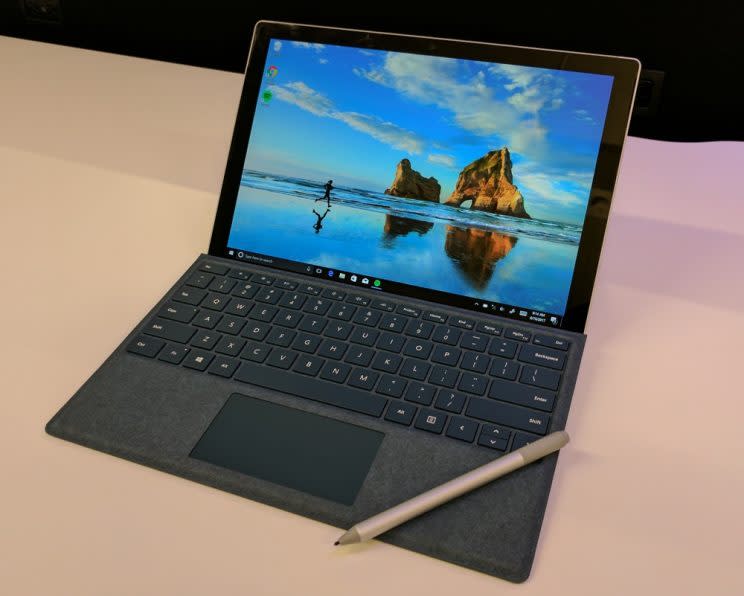
Haven’t we met before?
I’d be both impressed and a bit concerned if you could tell the difference between the Surface Pro 4 and new Surface Pro at a glance. That’s because the new Pro’s design hews so closely to its predecessor that any changes are incredibly subtle at best.
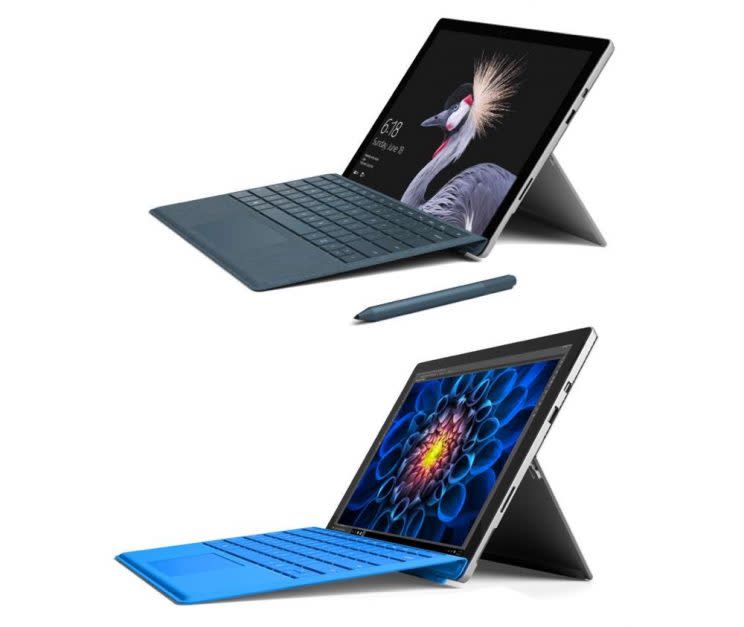
Microsoft points to the system’s newly curved edges and the lack of fan vents — on the Intel Core m3 and i5-powered versions only — as some of the 2-in-1’s most distinct changes.
At this point, I wish Microsoft would revamp the design a bit. Still, the fact that the company managed to pack a Core i5 processor into a device without a fan to keep it cool is seriously impressive. I, however, have the Core i7-powered model, which does have a fan and vent. But it’s not like it sounds like a jet engine or anything.

The biggest physical change to the Pro is its new kickstand. Now you can lean the Surface all the way back 165 degrees until it’s essentially flat on its back. Microsoft says this is to help make it easier for people who want to write on the Surface using their Surface Pen or use the Surface Dial accessory.
One of the best features of the Surface is its display. That’s been the case for the past few generations of Surface devices, and it’s no different this time around. The Pro’s 12.3-inch screen is beautiful, especially when using Microsoft apps like Office, Edge or others.

A slick stylus for a price
This time around, the Surface team improved the device’s display to work better with the new Surface Pen stylus. According to Microsoft, the Pen is more sensitive than its predecessor and suffers from less latency. The company says it cut down the response time for the Pen to 21 milliseconds. Microsoft also added a tilt feature to the Pen so you can create wide strokes with the stylus when you tilt it.
Apple’s (AAPL) new iPad Pro 12.9 inch, however, also features a more responsive stylus with a response time of just 20 milliseconds. Realistically, you’re not going to notice a 1-millisecond difference, but you know, bragging rights.
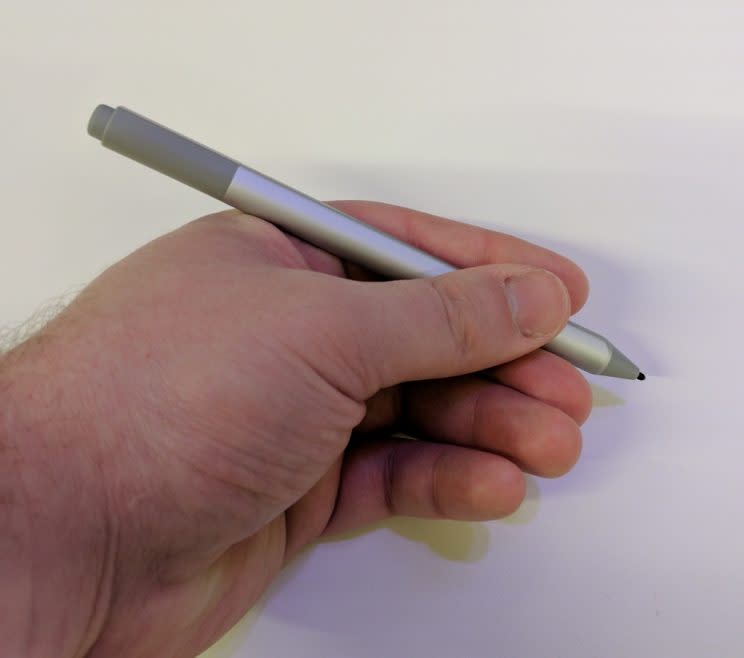
The Surface Pen’s performance is certainly impressive. Writing on the Pro’s screen genuinely does feel like you’re writing on a piece of paper. I didn’t notice a hint of lag even when scratching off a note. And the tilt function works just as advertised, though it didn’t seem to work with every app. I’m sure that will be helpful for artists, but all it did for me was give me a chance to add some extra flare to a few doodles around my notes.
My one beef with the Surface Pen is that it’s no longer included with the price of the Surface. Previously, Microsoft tossed in the stylus as part of the Surface package. But this time around you’ll have to shell out $99. That’s a heck of a lot of cash for a stylus. I previously criticized Apple for charging that much for its Apple Pencil stylus, and now Microsoft is doing the exact same thing. Sure, the new Surface Pen is supposed to offer improved performance, but it’s still a bad look.
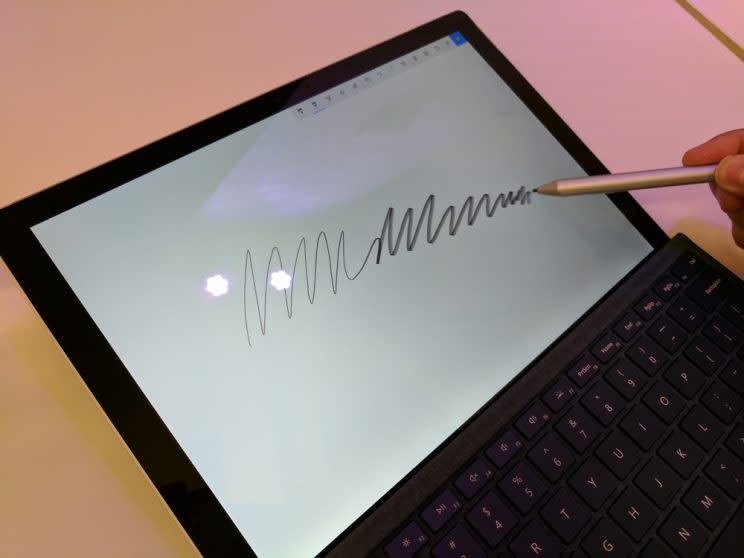
Paying to type
To get the full Surface Pro experience, you’ll have to also purchase a Surface Pro Type Cover for $129. Microsoft also sells the $159 Signature Surface Type Cover with its Alcantara fabric covered body, but outside of that, both keyboards are essentially the same.

I like typing on the Type Cover — I wrote this review with it — but still have the same complaint I’ve always had about the whole setup: it just doesn’t feel comfortable when working on your lap. The fact that you need to rest the kickstand on your knees means you’ve got to keep the Surface tucked close to your body when typing. Either that or I have unusually short thighs.
That said, I hardly ever use the Surface, or any laptop for that matter, on my lap. I’m usually sitting at a desk or table. If you tend to work on the bus or train, though, you might want to keep that in mind.
Power on the go
In terms of overall performance, the Surface Pro can range from a solid web-browsing machine to a full-on media consumption and creation device depending on your configuration. The base model, which starts at $799, comes with an Intel Core m3 processor, 4GB of RAM and a 128GB solid-state drive. That’s plenty of power for someone who just wants to surf the web — do people even say that anymore? — watch Netflix and send angry messages to celebrities on Twitter.
If you’re looking for a little more horsepower, there’s also the Core i5-powered model with 4GB of RAM and a 128GB SSD for $999. I’d suggest most people opt for the Pro with a Core i5 processor, 8GB of RAM and a 256GB SSD. If you want to max out your Surface, Microsoft offers a model with a Core i7 processor, 16GB of RAM and a 1TB SSD for $2,699.
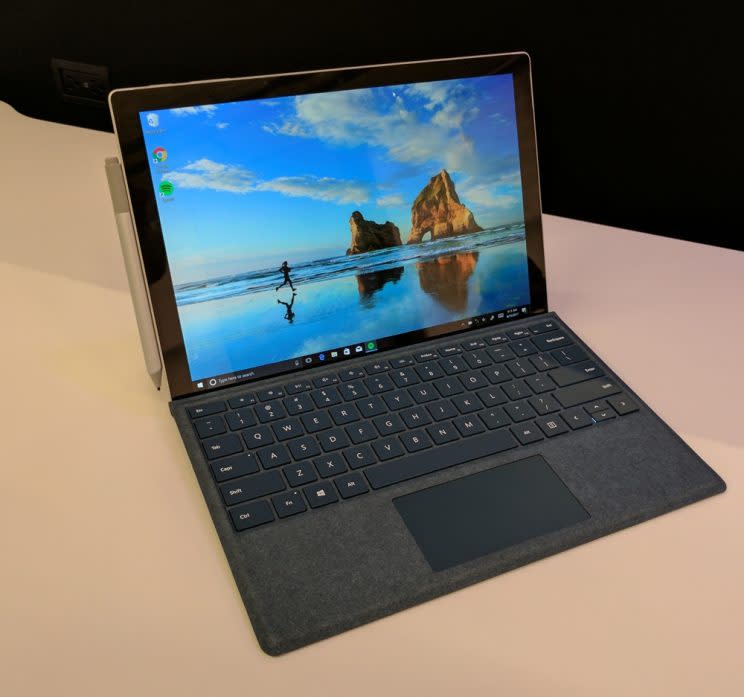
Don’t forget, you’ll need to add $139 for a keyboard and $99 for the stylus, too.
If you’re in the market for a similarly lightweight device, you can always opt for the 13-inch MacBook Air with a Core i5 processor, 8GB of RAM and a 128GB SSD for $999. If you want an insane amount of power you can go for a MacBook Pro with a Core i7 processor, 16GB of RAM and a 1TB SSD for $2,899. Still, neither of those devices have touch-screen displays nor can they double as tablets.
My Surface Pro review unit came with a Core i7 processor, 16GB of RAM and a 512GB SSD, and man is it a beast. I managed to stream videos on Netflix and Hulu, stream songs through Spotify, open 10 tabs in Chrome, download “Fallout Shelter,” mess around with Paint 3D and run a full system scan while writing this review and only noticed any slow down after about 15 minutes or so. In other words, this will easily handle pretty much anything you can throw at it.
Living through the day
Microsoft says the Surface Pro can get up to 13 and a half hours of battery life when playing video and with the display’s auto brightness feature turned off. I personally saw all-day battery life, meaning I got through my 8-hour work day, with the Surface Pro with the brightness between 25% and 50%. Push the brightness up to 100% and you’ll see the battery fall significantly faster.
Should you get it?
So, should you get the new Surface Pro? If you’re in the market for a premium laptop that can double as a tablet and can more handle your everyday tasks then I’d recommend going with the Surface Pro. If you don’t think you’re going to use the stylus more than once or twice, though, just save your $99.
More from Dan:
Email Daniel at [email protected]; follow him on Twitter at @DanielHowley.
